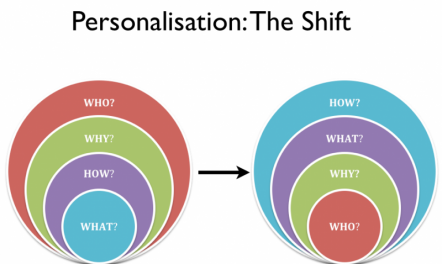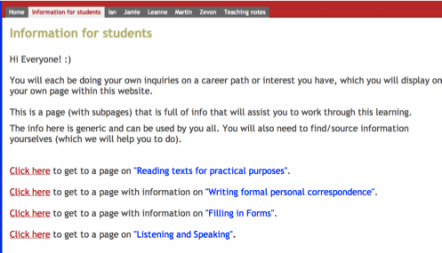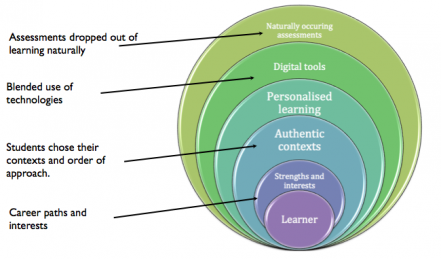You are here:
In order to make learning more meaningful, teacher Gareth Manins, from Cambridge High School, personalised learning in literacy for his year 11 students by making shifts from assessment-driven to learner-focused lessons, and from 'teacher in charge' to 'student in control'.
Teaching inquiry
Gareth felt the need to move the focus of his teaching away from an assessment-driven curriculum with siloed teaching and learning, where the teacher held the locus of control in the classroom. He wanted the focus of teaching and learning in his class to be on the learner, and to incorporate the use of technologies.
Gareth was concerned that previous students:
- were not enthused about their learning
- had low attendance rates
- had attained limited or no credits.
Gareth wanted to achieve better outcomes for his students so he decided to trial a new way of working – one that was strongly focused on putting the learner first.
To begin with, Gareth asked two questions:
- How can students engage in more self-directed learning based on strengths and interests?
- What deliberate acts of teaching underpin this framework?
Teaching and learning
A new way of working
Shifting the locus of control
In order to place more ownership in the students' hands, Gareth knew that he needed to step away from being the sole "knower" in the class. To accomplish this, he shifted the control from teacher to student, moving his role from "sage on stage" towards being more of a guide/mentor/facilitator.
Aligning the assessments
Working within the context of The Future is in My Hands, Gareth set about aligning the relevant assessments to ensure they matched the actual learning. For example, NZQA unit standards:
-
- US10792: Write formal personal correspondence
- US3483: Fill in forms.
 Cambridge High School: The future is in my hands
(PDF 587 KB)
Cambridge High School: The future is in my hands
(PDF 587 KB)
Establishing students' strengths and interests
Instead of starting with the assessment – the "what", Gareth started with the learner – the "who".
 Cambridge High: Personalisation: the shift
(PDF 135 KB)
Cambridge High: Personalisation: the shift
(PDF 135 KB)
To get the students underway with their inquiry, Gareth set out to find out the students' interests and strengths. He discovered that many students had part-time jobs and were keen to begin to craft their own career paths.
He got each student to inquire into their chosen career field. Tasks they undertook included:
- emailing correspondence asking for information about their career
- reading websites and informational brochures
- interviewing people already in that field of work.
 Cambridge High School: The future is in my hands
(PDF 587 KB)
Cambridge High School: The future is in my hands
(PDF 587 KB)
The students used a blend of technologies during the inquiry, compiling, for example, their information onto a Google site where they each had their own page.
 Cambridge High: Google site
(PDF 78 KB)
Cambridge High: Google site
(PDF 78 KB)
Gareth noted that as learning progressed assessments dropped out of the learning in a natural manner; even to the point where the students didn’t realise they were gathering them!
 Cambridge High: Personalisation
(PDF 125 KB)
Cambridge High: Personalisation
(PDF 125 KB)
Deliberate acts of teaching
The deliberate acts of teaching Gareth found were important to the success of this strategy included:
- bringing about a shift in locus of control – from teacher to student
- starting with the "must haves" – qualifications/assessments
- creating a context for learning that is meaningful, relevant, and authentic for each student
- negotiating the learning with students
- scaffolding the learning
- activating student agency
- blending the learning – a combination of classroom based activities and using digital technologies.
Outcomes
The classroom activity changed from credit-focused teaching without real world application, to engaged learners who were collaborating, reflecting, and achieving.
Gareth noted that the change in approach brought about more cross-talk amongst the students – for example, students talking about jobs they were interested in (trades, professions, armed services, the local supermarket).
He said, "Before we had distinct research and writing periods with little collaboration. This time we moved back and forth between the two with lots of discussion."
The students each researched an actual job they wanted to find out about, involving actual real-world forms, for example, Wintec documentation.
Some students had talked with other teachers, for example, the technology teacher or career advisor. asking questions such as, "Can I take this home and talk to Mum and Dad about it?".
This research wasn’t directly credit-based but it did enrich the learning.

What I liked was that the kids didn't even recognise they were getting the credits.

Gareth Manins - Teacher, Cambridge High School
With students having a relevant purpose and audience for their writing, they were able to make more sense of editing and other information skills. Incorporating the use of IT throughout the inquiry, instead of IT being the point or focus of a lesson, extended and deepened the learning, as well as allowing for collaboration and reflection "anytime, anywhere".
Key messages
The key messages from Gareth for other teachers wishing to make the same shifts in their classrooms are:
- make learning more authentic, real, and relevant
- set students up to succeed
- reposition yourself as a co-learner and facilitator of learning.
Next steps
The next steps for Gareth are to:
- start the whole programme with a focus on learning outside the classroom and basing learning on students' interests
- shift away from "assessment-driven" teaching to a more integrated, personalised approach.
Other information and stories
Read these stories about personalised assessment practices:
Listen to these podcasts with similar messages:
Return to top







